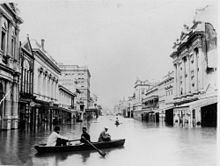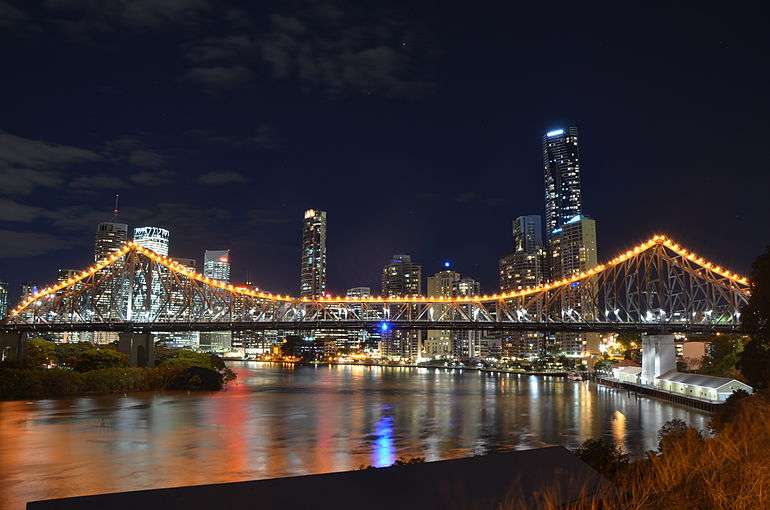Brisbane
![]()
The title of this article is ambiguous. For other meanings, see Brisbane (disambiguation).
Brisbane [ˈbɹɪzbən] is the capital of the state of Queensland in northeastern Australia.
The city is located on the Brisbane River near its mouth in the Coral Sea. The metropolitan area has two million inhabitants. Brisbane is both a Catholic (Archdiocese of Brisbane) and Anglican archbishopric. An important economic sector is the petroleum industry. Brisbane was founded in 1824 under the name Moreton Bay as a penal colony and was later named after Sir Thomas Brisbane, the then governor of New South Wales.
Brisbane is known for its universities (including the Queensland University of Technology, University of Queensland and Griffith University) and also for the holiday paradises of the Sunshine Coast and Gold Coast, which begin north and south of the city limits, for its ocean location and generally good weather.
In Australian English, which is dominated by abbreviations, Brisbane is occasionally also referred to as Brissie. In addition, there are joking name variations such as Bris Vegas or Brisneyland, which are used only sporadically.
In a 2018 ranking of cities by their quality of life, Brisbane ranked 37th out of 231 cities surveyed worldwide.
History
In search of a suitable location for a new penal colony, soldier and explorer John Oxley landed on the Brisbane River in 1823. The original colony was established at Redcliffe in 1824, but a year later it was moved upriver to the area that is now the city centre.
In 1842, the penal colony was dissolved and the land was opened for free settlement. After the secession of New South Wales in 1859, Brisbane was named the capital of the new colony of Queensland. However, the city was not officially granted city rights until 1902.
With the merger of several surrounding towns and settlements as well as several administrative districts, the foundation stone for today's Brisbane was finally laid in 1925.
During the Second World War, Brisbane was for a time the headquarters of 5-star General Douglas MacArthur, the supreme commander of Allied forces in the southwest Pacific. In November 1942, serious rioting broke out between Australian and American soldiers, resulting in the death of one Australian soldier and injuries to several hundred soldiers on both sides, as well as some civilians.
In 1893, 1974, and 2011, the city was hit by serious floods that inundated much of the downtown area.
After the foundation stone was laid in 1901, the Anglican St. John's Cathedral, the last cathedral built in the neo-Gothic style, was built from 1903 to 2008. Its consecration was on 29 October 2009.
In 1912, a dispute over the wearing of union badges by tramway employees led to a five-week general strike in Brisbane. The demonstrations, joined by an increasing number of trade union organisations, brought public life in the city to a standstill. The government then issued a ban on demonstrations and issued bayonets to the police.
In 1982 Brisbane hosted the Commonwealth Games and in 1988 the World Expo. Brisbane was one of the venues for the 1987 Rugby Union World Cup, the 1992 Cricket World Cup, the 2003 Rugby Union World Cup and the 2015 Cricket World Cup, among others.

Queen-Street in Brisbane during the flood of 1893
Geography
Brisbane is located in southeast Queensland, 70 km north of the Gold Coast (Australia). The city lies near the mouth of the Brisbane River, which meanders through the city and suburbs. The Brisbane metropolitan area lies on the plain between the Great Dividing Range and the coast. Although the area is relatively flat, some hills in the city are up to 300 m high, such as Mount Coot-tha or Mount Gravatt.
On 10 January 2011, the Brisbane River overflowed its banks in Brisbane, flooding streets and parks. As the water fell on 14 January, it was announced that 30,000 buildings had been damaged by the flood and about 40,000 were without power, and that initial clean-up work had begun in areas of the city that had been cleared of water. It was determined on January 14 that there had been 26 deaths and that 53 people were missing.
Urban structure
The city centre, the Central Business District (CBD), is located on an area of the Brisbane River with strong bends. It covers an area of 2.2 km². Streets in the city centre are named after members of the royal family. Streets with women's names run east-west, those with men's names run north-south. Queen Street is the historic main street. It ends in the bustling pedestrian precinct. Queen Street is characterized by historic buildings and cultural institutions. To the south, east and west, the Brisbane River borders the CBD.
The districts of Fortitude Valley, Spring Hill and Paddington, which lie to the north of the city centre, are known for their numerous eateries, many shopping opportunities and alternative nightlife. On the south side of the river adjacent to the CBD is South Brisbane. Due to the extensive South Bank Parklands, this part of the city serves as a recreational area for residents and tourists. Various museums and cultural centres have been built along the waterfront of the parklands. The connecting bridges between the city centre and South Brisbane are the Victoria Bridge and the Kurilpa Bridge. While the Victoria Bridge is passable for motor vehicles, bicycles and pedestrians, the Kurilpa Bridge can only be used by cyclists and pedestrians. Other districts close to the city south of the river are West End and Kangaroo Point. Brisbane International Airport and Port Brisbane at the mouth of the Brisbane River were built about 15 kilometers northeast of the Central Business District. The outer area of the metropolis is bordered by Caboolture, Beenleigh, Ipswich and Moreton Bay.
Compared to other major Australian cities such as Sydney or Melbourne, the population density in the inner city is relatively low at 379.4 inhabitants per square kilometre. This is due to the high proportion of detached houses, which were also built in the city centre in the traditional Queenslander style until the 1950s. Later, more large apartment blocks were built. It is only in recent years that striking skyscrapers have been built in Brisbane. The tallest building in the city is currently the Infinity Tower with a height of 249 m, then Soleil with 243 m.
See also: List of districts of Brisbane
Climate
Brisbane has a subtropical climate with warm, sultry summers and mild, dry winters. Humidity is very high from November to April. Thunderstorms and hailstorms occur throughout the year. In recent years, Brisbane has suffered from prolonged drought in the summer months.
| BRISBANE | ||||||||||||||||||||||||||||||||||||||||||||||||
| Climate diagram | ||||||||||||||||||||||||||||||||||||||||||||||||
| ||||||||||||||||||||||||||||||||||||||||||||||||
| Monthly average temperatures and precipitation for BRISBANE
Source: | ||||||||||||||||||||||||||||||||||||||||||||||||||||||||||||||||||||||||||||||||||||||||||||||||||||||||||||||||||||||||||||||||||||||||||||||||||||||||||||||||||||||||||||||||||||||||||||||||

The Story Bridge
Questions and Answers
Q: What is Brisbane?
A: Brisbane is the seaport capital city and biggest city of Queensland in Australia.
Q: How many people live in Brisbane?
A: Brisbane has a population of 2.2 million people.
Q: What is the position of Brisbane in terms of size compared to other Australian cities?
A: Brisbane is Australia's third biggest city, after Sydney and Melbourne.
Q: Where is the central city of Brisbane located?
A: The central city of Brisbane is on the Brisbane River, 23 kilometres (14 mi) inland from Moreton Bay.
Q: How did Brisbane get its name?
A: Brisbane is named after the Brisbane River, which in turn is named after Sir Thomas Brisbane who was Governor of New South Wales from 1821-1825.
Q: When was the first penal colony established in Brisbane and where was it located?
A: The first penal colony was founded at Redcliffe, 28 kilometres (17 mi) to the north, in 1824.
Q: When did Brisbane become the capital city?
A: Brisbane became the capital city when Queensland became a separate colony from New South Wales in 1859.
Search within the encyclopedia